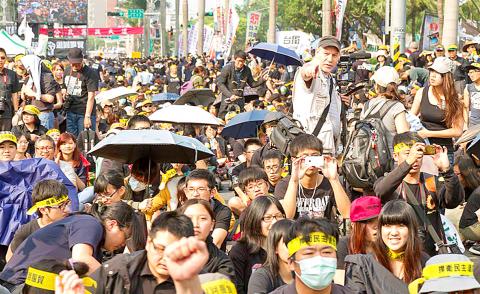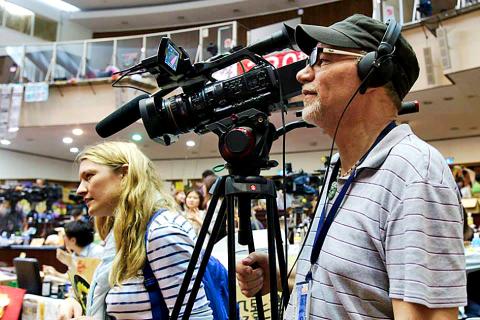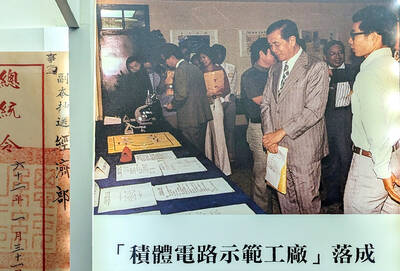Tobie Openshaw braced himself for violence and tear gas as he headed out the door with his cameras to the Legislative Yuan, just like he did in his native South Africa decades ago.
“I was loaded for bear,” he says.
But it turned out that the 2014 Sunflower movement protests were more peaceful than Openshaw could have imagined. Last time he covered a protest, was in the mid-1980s at the height of apartheid violence in his home country, where there were legitimate concerns that he could be killed.

Photo courtesy of Tobie Openshaw
“I just can’t believe that people can actually protest in this way, so peacefully but yet so firmly,” Openshaw says. “We’re just sitting here. We’re not doing anything but... it was super powerful.”
The filmmaker was mostly shooting for various media outlets, but he also spent personal time at the scene as he could “no longer stay away as an observer.”
He will show video clips and talk about his experiences at the protests on July 21 at the Academia Sinica Research Center for Humanity and Sciences for a program organized by the French Center for Research on Contemporary China.

Photo courtesy of Tobie Openshaw
When Openshaw first arrived at the legislature, he noticed that while emotions were high, there was no anger or scuffles. Students were on the balcony waving their cellphones and singing a protest song, while the police were virtually invisible.
“I was immediately struck by how people were working to keep this peaceful and non-confrontational,” he says. “People on the microphones were going, ‘The police are not our enemy. You are also Taiwanese and we are fighting for you too.”
Even when there were clashes during the protests such as the Executive Yuan occupation, Openshaw says it was done in a civil manner.
“That was tame in comparison [to South Africa],” he says. “The police were virtually apologizing to these kids, [basically saying] ‘We’re sorry but we have to pick you up and remove you.’”
External support was also impressive as food and water arrived, charging stations were set up and a phone company provided free Wi-F.
Openshaw also interview gangster Chang An-le (張安樂), also known as the White Wolf, who attempted to enter the legislature with his followers, but were blocked by legislators and the police.
“We were really going into the lion’s den,” he says. “We were not threatened at all, but it’s that mafia thing, where it’s like, ‘You are my friend, please sit down, my friend, let me make sure you’re my friend.’ But there’s just a little implication that this could switch at any moment.”
Openshaw will also talk about the media’s handling of the event — for example, how one outlet wasn’t interested in the story because there was little violence. He also noted the effective use of social media, as well as the way the students’ self-discipline, from trash control to meticulously removing the posters they put up, even cleaning the glue with alcohol.
Just a few days into the protest, Openshaw knew that this was a historic moment that would change Taiwanese history.
“The perception of Taiwanese [youth] being strawberries [was] easily squashed [during the protests]. I saw bravery there,” he says.

Oct. 27 to Nov. 2 Over a breakfast of soymilk and fried dough costing less than NT$400, seven officials and engineers agreed on a NT$400 million plan — unaware that it would mark the beginning of Taiwan’s semiconductor empire. It was a cold February morning in 1974. Gathered at the unassuming shop were Economics minister Sun Yun-hsuan (孫運璿), director-general of Transportation and Communications Kao Yu-shu (高玉樹), Industrial Technology Research Institute (ITRI) president Wang Chao-chen (王兆振), Telecommunications Laboratories director Kang Pao-huang (康寶煌), Executive Yuan secretary-general Fei Hua (費驊), director-general of Telecommunications Fang Hsien-chi (方賢齊) and Radio Corporation of America (RCA) Laboratories director Pan

President William Lai (賴清德) has championed Taiwan as an “AI Island” — an artificial intelligence (AI) hub powering the global tech economy. But without major shifts in talent, funding and strategic direction, this vision risks becoming a static fortress: indispensable, yet immobile and vulnerable. It’s time to reframe Taiwan’s ambition. Time to move from a resource-rich AI island to an AI Armada. Why change metaphors? Because choosing the right metaphor shapes both understanding and strategy. The “AI Island” frames our national ambition as a static fortress that, while valuable, is still vulnerable and reactive. Shifting our metaphor to an “AI Armada”

The older you get, and the more obsessed with your health, the more it feels as if life comes down to numbers: how many more years you can expect; your lean body mass; your percentage of visceral fat; how dense your bones are; how many kilos you can squat; how long you can deadhang; how often you still do it; your levels of LDL and HDL cholesterol; your resting heart rate; your overnight blood oxygen level; how quickly you can run; how many steps you do in a day; how many hours you sleep; how fast you are shrinking; how

When Taiwan was battered by storms this summer, the only crumb of comfort I could take was knowing that some advice I’d drafted several weeks earlier had been correct. Regarding the Southern Cross-Island Highway (南橫公路), a spectacular high-elevation route connecting Taiwan’s southwest with the country’s southeast, I’d written: “The precarious existence of this road cannot be overstated; those hoping to drive or ride all the way across should have a backup plan.” As this article was going to press, the middle section of the highway, between Meishankou (梅山口) in Kaohsiung and Siangyang (向陽) in Taitung County, was still closed to outsiders